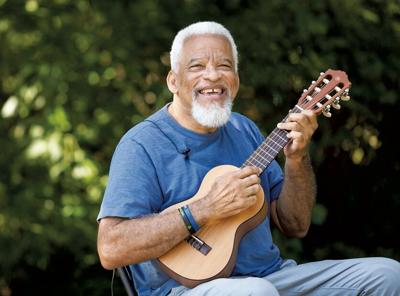Did you just look at the title of this article and think “What does creating have to do with me? I’m certainly no Vincent van Gogh or Mark Twain.” Did you immediately think that this article is for all those creative geniuses out there, and you’re not one of them?”

Well, wait a minute! Before you move on, be assured that this article is about you and for you, whether you know it or not.
Consider the story of Stuart…
Stewart was a technology whiz, with a PhD in computer science. His career at a university on the West Coast involved detailed, mind-taxing work with computers and data, along with some teaching about the same.
He was the son of an artist but felt no draw towards creative work himself. Or so he thought. However, he did appreciate art and music, and, occasionally, even poetry.
So, who could anticipate that Stuart’s hobby, that later turned into his retirement enterprise, would be the cello? And by this, I mean the cello start to finish, beginning with building his own cello, then learning to play it.
Where in the world did that come from? And how did he discover this to be his engaging creative passion?
What Does Creating Have to Do with You?
So, returning to the initial question… What does creating have to do with you? During your major career, were you a builder or a nurse, an executive or a business owner? So, in your mind, do you assume you are just not the creative type? Well, what exactly is the creative type? And what do they create?
To address this question, your mind probably goes first to the “core” creatives, people with special talents like painting, writing, sculpting, designing, composing music. These “core” creatives can miraculously start from a blank page or canvas and end up with something unique and possibly brilliant. But creation goes beyond these “core” areas. And it is not the domain of the tortured, hyper-talented few. Perhaps you are a person who can create new ideas, new technologies, new content, new services, or new solutions to complex problems.
Like the rest of us, creativity was something you readily and naturally expressed as a child. In our imaginative play as children, we constructed stories, and told them from multiple perspectives. We enlisted others to take on roles in those stories. We made up worlds out of cardboard boxes and magic markers. Why did we do this, and how? And what does this have to do with now? The fact is that we all are “wired” to create. Creating is displayed in many ways. New ideas or experiences. Expressing our “self” through words, photos, art, craft, music. Constructing personal meaning from experiences. Imagining other perspectives. Applying stories from one milieu or time or situation to another. Reflecting on mental and emotional states. And if we all are wired to create, this means that you are too.
Why Create?
Creativity has many faces and forms, but the deeper question is… Why create? And more to the point, why create after retirement when you already have had your fill of work? What are the benefits of exploring and engaging your creative side? In a nutshell, consider this: Creative endeavors are associated with positive emotion, flourishing and well-being.
Research has shown that there is a clear connection between creative pursuits and a sense of well-being. And this sense is long-lasting. People who engage in a creative endeavor experience increases in positive emotions and flourishing, both on the day they engage in the activity and in the days that follow. These positive emotions include energy, enthusiasm, and excitement. In a study of 650 adults conducted by the University of Otago in New Zealand, each participant kept a diary for 13 days to record time spent daily in creative endeavors as well as their feelings of well-being in terms of: 1) positive emotion, 2) flourishing and 3) sense of meaning, purpose, engagement and social connection.
The results were striking. Those who engaged in creative activity experienced more positive emotions that day. And significantly, these positive emotions carried over to the next day and beyond. This clear connection between creativity and well-being was true for all, not just for those few who had extraordinary artistic talents. Small daily acts of creativity influence overall well-being, both in the moment and afterwards. For everyone.
The How’s: Traits and Habits to Find Your Creative Side
So where and how do you find your own creative affinity? What do you do to discover it? Well, here’s the irony… Creativity resides in the part of our brains that works when we’re not purposely engaged in something else. According to psychologist Scott Barry Kaufman’s ground-breaking research, as detailed in his book Wired to Create: Unraveling the Mysteries of the Creative Mind: “Creativity is a habit… A way of life… It is a style of engaging with the world.” And it is a spirit that resides in all of us.
Kaufman outlines 10 practices and habits that guide us to our deepest creativity. The first six are:
Imaginative Play – The wellspring of natural creativity, taking on multiple perspectives and playfully manipulating emotions and ideas.
Passion—Can lead to inspiration… to endeavors that “resonate.”
Daydreaming—Which is not a waste of time but is the time needed for: creative incubation, self-awareness, future planning, reflection on the meaning of experience, and compassion. Allow your mind the freedom to wander.
Solitude—Essential to feeding the creative mind. Creative ideas are stifled while we are engaged outwardly. Your creative mind requires mental space and quiet through solitary reflection.
Intuition— A spontaneous mental process that arises from the unconscious mind… Part of the “fast brain” system through which our mind assimilates new information into existing structures, recognizes complex patterns, and makes unconventional connections that lead to original ideas and solutions.
Openness to Experience—Leads to a deeper level of self-understanding, and self-expression. The drive for cognitive exploration of one’s inner self and outer self predicts creative achievement.
The take-away is that to access and cultivate our creative side, we need to give our minds the space and the quiet to roam. Turn off the constant babbling of the TV. Take a break from social media. Spend time alone. We need to have the desire to learn and discover, then act on this, staying open to new experiences. And as our creative endeavors of choice come to mind, we need to make sure that we develop the self-understanding to find the one or ones that resonate with us.
The paradoxes: We need both mindfulness and mind wondering. We need both openness and sensitivity. We need both play and seriousness. We need both intuition and reason. All of these contribute to the creative process.
Beyond Self
“The greatest of human potentials is the potential of each of us to empower and acknowledge the other… Our greatest genius may be the ability to prime the healing and evolutionary circuits of one another…we have the power to restore to one another the glory of who we are” (from “The Possible Human” by Jean Houston).
Just as we each can benefit from finding our own creative side, so too can we pass this on and draw this out from others. For starters consider storytelling. We have lost the tradition of telling the stories of our past. By activating childhood memories, we “prime” our memory banks. By learning and passing on the fundamentals of storytelling—gaining attention, creating characters and conflict, crafting the visuals and details, the villain, and the philosophical problem—we can create our own life stories. Our stories can take written form, or be told at gatherings, or turned into videos or podcasts.
Why Start Creating Now, During Retirement?
If you are thinking, “Well this all sounds wonderful, but it’s just too late for me to start now,” then think again. Perhaps during your youth, you had experience or even some success with one of the core areas of creativity. But maybe this encounter with and urge towards a creative art ended abruptly when you recognized that it would not be a practical pursuit to earn a reasonable living. Even if you have always considered the creative life to be impractical, rethink the possibilities now that your life realities have changed. What may once have seemed unrealistic as a means for you to earn a living, may be just the pathway that will suit and stretch you now that earning power is not your primary concern. Allow your singular gifts to flourish.
Even if you think that you have had your fill of anything that resembles work, then consider the differences. When you are engaged in a creative pursuit, you will experience and use time differently, tending towards long periods of intense concentration, punctuated by complete breaks in productivity when you need to relax and recharge, or to incubate ideas. Your efforts will be self-managed, and you will set your own hours. You will be drawn to learn and grow, and to shape the content of your own work… To express your identity through your work. And you will be drawn to stimulating, creative environments and people where you feel free to express yourself.
So, incorporate more creativity into your daily life. This can be through activities such as writing, cooking, knitting… It can be through explorations such as traveling… Or finding novel solutions to problems… Or inventing a better mousetrap… It can be through learning to play the autoharp.
Now retired from a 40-year career in education, Dr. Duckworth co-authors, with Dr. Marie Langworthy, Shifting Gears to Your Life & Work After Retirement and the QuickSwitch to Working Online series, available on Amazon. She also co-authors, with son Brian Lane, the “Great Trip Guide” Series—detailed guidebooks to taking memorable, immersive, fully independent trips in Europe, Canada and the USA (GreatTripGuide.com). Contact Carolee Duckworth at cwcamer@charter.net.
Related Articles & Free Vermont Maturity Subscription

Have a Good Think About Learning after Retirement
Learning Opportunities Boomers & Seniors May Not Know About





Comment here